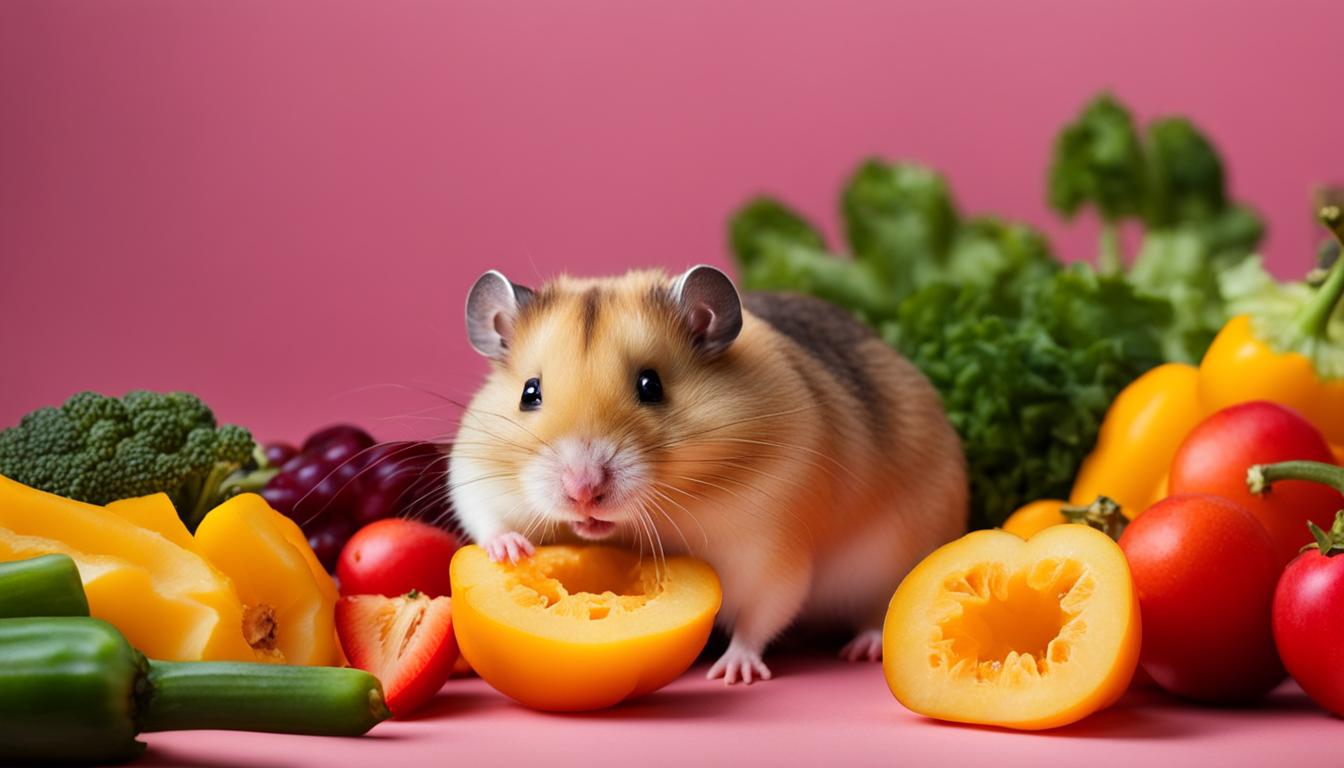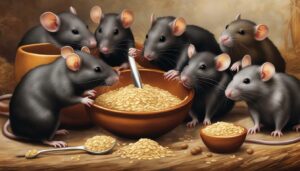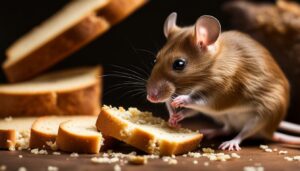As a responsible pet owner, you want to ensure that your hamster has a safe and nutritious diet. One question that often arises is whether hamsters can eat yellow peppers.
Well, the good news is that hamsters can enjoy the occasional yellow pepper treat! But like with any food, moderation is key.
Hamsters require a balanced diet that includes a variety of foods to meet their nutritional needs. This includes species-appropriate pellet feed, hay, seeds, nuts, fruits, vegetables, and grains.
Yellow peppers, along with other bell peppers, can be a healthy addition to your hamster’s diet.
Key Takeaways:
- Hamsters can eat yellow peppers in moderation as part of a balanced diet.
- Yellow peppers are rich in nutrients such as water, carbohydrates, fats, proteins, fiber, vitamins, and minerals.
- Overfeeding yellow peppers can lead to digestive issues or diarrhea in hamsters, so it’s important to offer them in moderation.
- Proper serving sizes for yellow peppers are small pieces that fit comfortably in a hamster’s cheek pouches.
- It’s important to introduce new vegetables gradually and monitor your hamster for any adverse reactions.
Benefits and Risks of Feeding Yellow Peppers to Hamsters
Yellow peppers offer several health benefits for hamsters due to their nutritional content. They are rich in antioxidants, including vitamin C, which can support the immune system and help protect against disease.
While hamsters can produce their own vitamin C, including yellow peppers in their diet can provide additional support for their overall health.
Yellow peppers also contain important vitamins and minerals that contribute to hamsters’ well-being, such as potassium and magnesium.
These nutrients play a vital role in maintaining healthy bodily functions, supporting proper muscle and nerve function, and promoting overall vitality.
However, it’s crucial to feed yellow peppers to hamsters in moderation and not as the primary food source.
Although rich in nutrients, peppers also contain moderate amounts of naturally occurring sugars.
Overfeeding peppers, especially those with higher sugar content like red and orange bell peppers, can lead to obesity, digestive issues, and other health problems in hamsters.
It’s important to balance a hamster’s diet with a variety of foods to ensure they receive all the necessary nutrients while avoiding excessive sugar intake.
Best Vegetables for Hamsters
In addition to yellow peppers, there are several other safe vegetables that hamsters can enjoy. Some examples include green bell peppers, zucchini, broccoli, red lettuce, spinach, artichoke, basil, carrot, green beans, celery, squash, cauliflower, pumpkin, cilantro, parsley, cabbage, and asparagus.
These vegetables offer a variety of nutrients and flavors that can be included in a hamster’s diet. It’s important to introduce new vegetables gradually and monitor the hamster’s reaction to ensure they tolerate them well.
Remember to always wash the vegetables thoroughly and remove any uneaten portions to prevent spoilage in the hamster’s cage.
By including a variety of safe vegetables, such as yellow peppers, in a hamster’s diet, pet owners can provide a balanced and nutritious meal that supports their furry friend’s overall health and well-being.
Feeding Yellow Peppers to Hamsters: Moderation and Proper Serving Sizes

When it comes to incorporating yellow peppers into your hamster’s diet, moderation is key. While yellow peppers offer various nutritional benefits, overfeeding can lead to digestive issues and other health problems.
To ensure your furry friend enjoys the benefits without any adverse effects, it’s essential to follow proper serving sizes.
Hamsters have cheek pouches for storing and transporting food, so it’s crucial to provide small pieces of yellow pepper that can fit comfortably.
A good rule of thumb is to offer a piece of pepper that is approximately the same length as your hamster’s head.
Avoid chopping the pepper into smaller pieces, as hamsters should be encouraged to chew their food to wear down their teeth.
Proper serving size:
– Offer one piece of yellow pepper, roughly the same length as your hamster’s head
– Thoroughly wash the yellow pepper before serving to remove dirt or pesticides
– Avoid feeding spoiled or moldy food
– Monitor your hamster for any signs of digestive issues or allergic reactions
By adhering to these guidelines, you can ensure that your hamster enjoys the nutritional benefits of yellow peppers while promoting their overall well-being.
Remember, it’s always advisable to consult a veterinarian if you have any concerns about your hamster’s diet or health.
Other Safe Vegetables for Hamsters

While yellow peppers are a safe and nutritious vegetable for hamsters, it’s always good to provide them with a variety of options to keep their diet interesting and balanced.
Here are some other safe vegetables that you can include in your hamster’s menu:
1. Green bell peppers: Similar to yellow peppers, green bell peppers are a great source of vitamins and minerals for your furry friend.
2. Zucchini: This mild-flavored and hydrating vegetable is a favorite among hamsters and provides essential nutrients.
3. Broccoli: Rich in fiber, vitamins, and minerals, broccoli can be a healthy addition to your hamster’s diet in small portions.
4. Red lettuce: This leafy green vegetable is low in calories and can be fed to your hamster in moderation.
Remember to always wash the vegetables thoroughly before serving them to your hamster and introduce new foods gradually.
Also, be sure to remove any uneaten portions to prevent spoilage in your hamster’s cage. By providing a variety of safe vegetables, you can ensure that your hamster’s nutritional needs are met while keeping their diet enjoyable.
Conclusion
In conclusion, when it comes to hamster diets, yellow peppers can indeed be a safe and nutritious addition.
They offer a variety of essential nutrients, including vitamins, minerals, and antioxidants that contribute to your hamster’s overall health.
However, it’s crucial to remember that moderation is key. Yellow peppers should not be the main food source but rather a supplement to a balanced and varied diet.
Remember to follow proper serving sizes and provide small pieces of yellow pepper that can comfortably fit in your hamster’s cheek pouches.
It’s also important to offer a diverse range of foods, including other safe vegetables and fruits, as well as species-appropriate pellets.
By doing so, you can ensure that your hamster receives all the necessary nutrients for optimal health and well-being.
If you notice any digestive issues or allergic reactions after feeding yellow peppers or any other food to your hamster, it’s vital to consult a veterinarian.
They can provide guidance and advice tailored to your hamster’s specific needs. Your veterinarian can also help you establish a suitable diet plan and address any concerns you may have about your hamster’s nutrition or overall health.
By following these recommendations and guidelines, you can provide your furry friend with a safe and nutritious diet.
Remember, a healthy hamster is a happy hamster!
FAQ
Can hamsters eat yellow peppers?
Yes, hamsters can eat yellow peppers in moderation as part of their balanced diet.
What are the nutritional benefits of yellow peppers for hamsters?
Yellow peppers are rich in nutrients such as water, carbohydrates, fats, proteins, fiber, vitamins (like vitamin C), and minerals (such as potassium and magnesium).
How much yellow pepper should I feed my hamster?
A recommended serving size is one piece of pepper that is approximately the same length as the hamster’s head.
Can I feed my hamster other vegetables besides yellow peppers?
Yes, there are several other safe vegetables that hamsters can enjoy, including green bell peppers, zucchini, broccoli, red lettuce, spinach, and more.
What should I do if my hamster shows signs of digestive issues after eating yellow peppers?
If your hamster experiences digestive issues or allergic reactions, it’s important to consult a veterinarian for further guidance.




